Evaluating the Design and Construction of the Hume Dam
VerifiedAdded on 2023/06/08
|11
|2967
|269
Report
AI Summary
This report assesses the design process of the Hume Dam, focusing on its conceptual design. It delves into aspects such as feasibility studies, system planning, functional analysis, system operational requirements, maintenance, and performance measurement. The Hume Dam, originally known as Hume Weir, serves multiple purposes, including water conservation, domestic and industrial water supply, irrigation, hydropower generation, and flood mitigation. The report traces the dam's origins to the 19th century, highlighting the need for reliable water supply along the Murray River. It examines the roles of New South Wales and Victoria in the dam's construction, the reasons for its design, and its functional components, including the dam and spillways, reservoir, and power station. The report also discusses maintenance efforts and performance measurement, emphasizing the dam's importance to the local community.
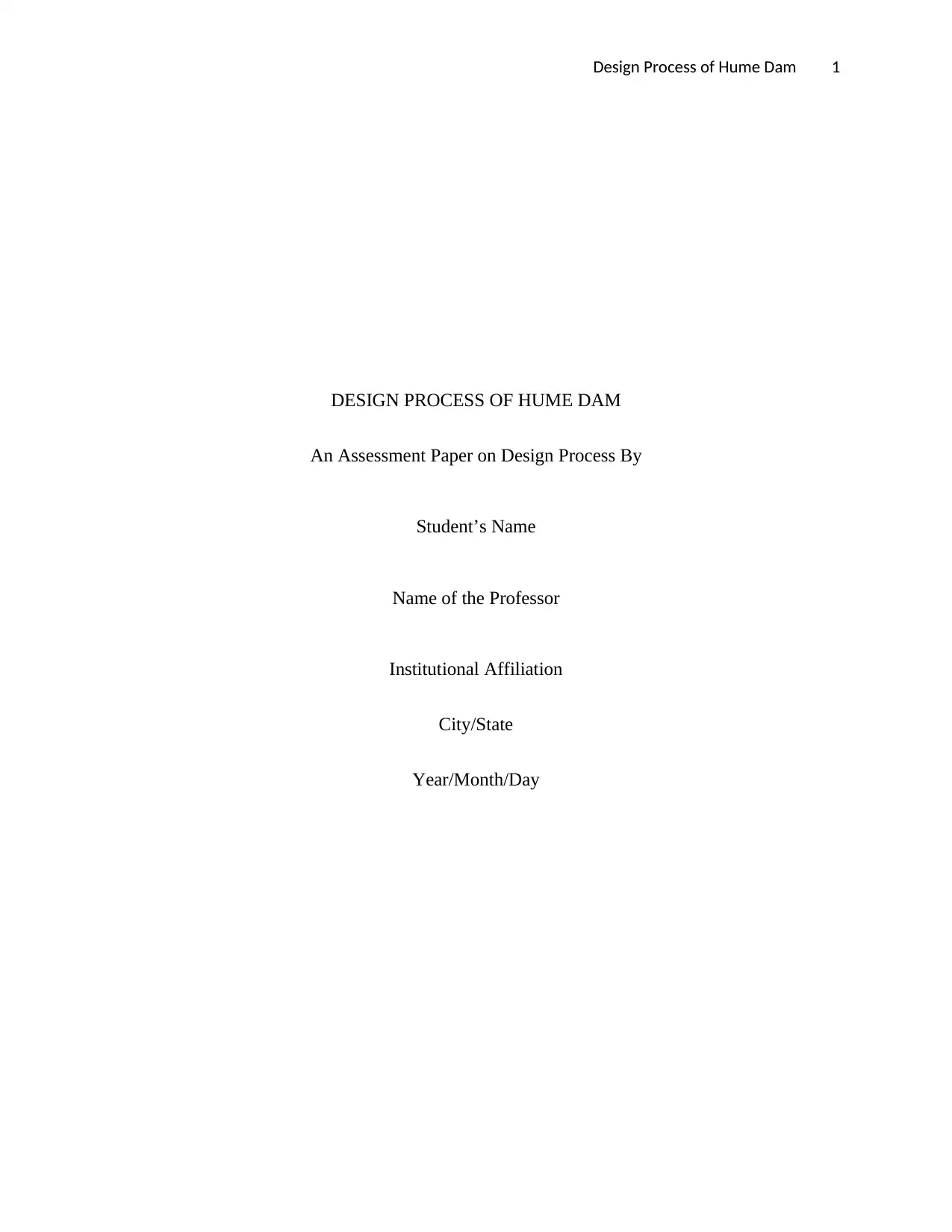
Design Process of Hume Dam 1
DESIGN PROCESS OF HUME DAM
An Assessment Paper on Design Process By
Student’s Name
Name of the Professor
Institutional Affiliation
City/State
Year/Month/Day
DESIGN PROCESS OF HUME DAM
An Assessment Paper on Design Process By
Student’s Name
Name of the Professor
Institutional Affiliation
City/State
Year/Month/Day
Paraphrase This Document
Need a fresh take? Get an instant paraphrase of this document with our AI Paraphraser
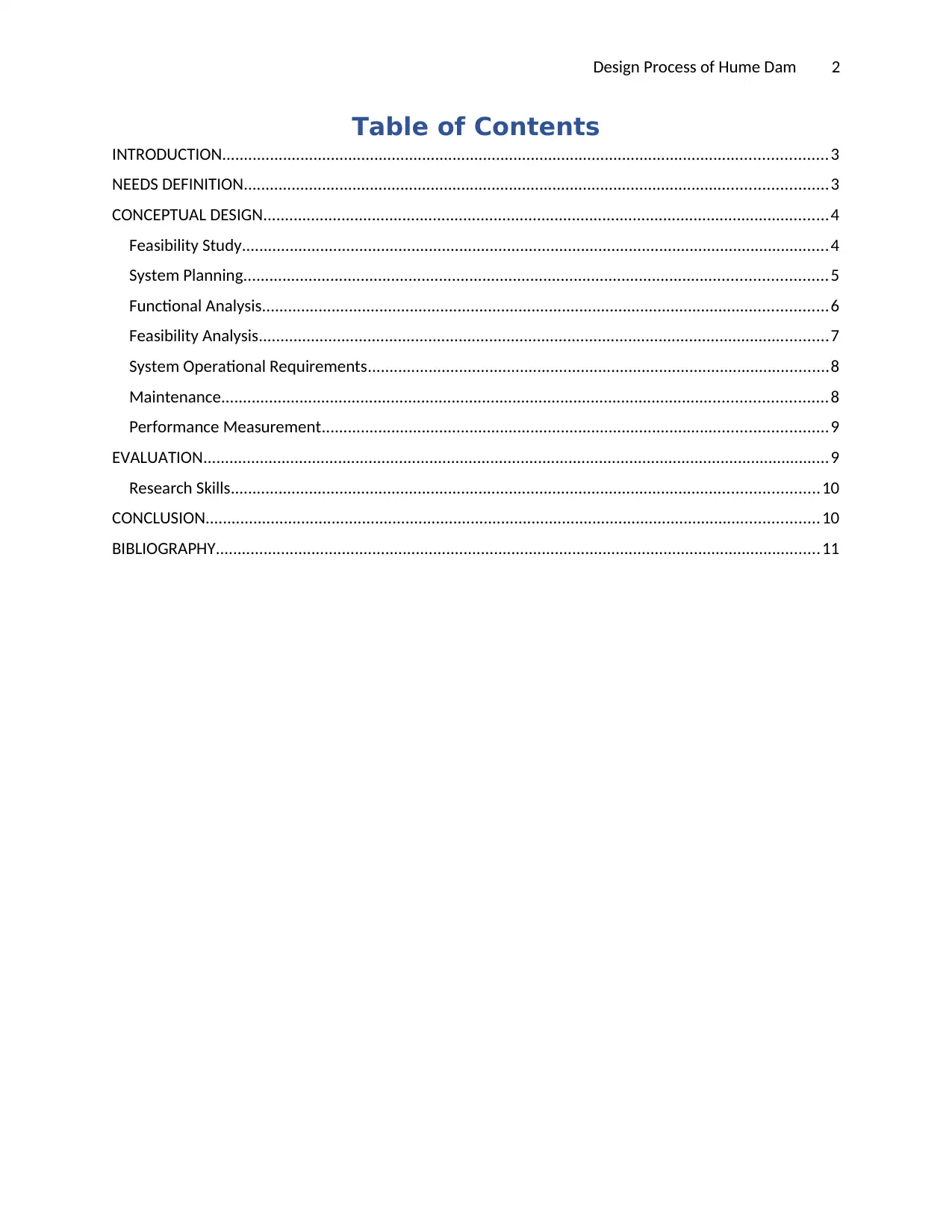
Design Process of Hume Dam 2
Table of Contents
INTRODUCTION...........................................................................................................................................3
NEEDS DEFINITION......................................................................................................................................3
CONCEPTUAL DESIGN..................................................................................................................................4
Feasibility Study.......................................................................................................................................4
System Planning......................................................................................................................................5
Functional Analysis..................................................................................................................................6
Feasibility Analysis...................................................................................................................................7
System Operational Requirements..........................................................................................................8
Maintenance...........................................................................................................................................8
Performance Measurement....................................................................................................................9
EVALUATION................................................................................................................................................9
Research Skills.......................................................................................................................................10
CONCLUSION.............................................................................................................................................10
BIBLIOGRAPHY...........................................................................................................................................11
Table of Contents
INTRODUCTION...........................................................................................................................................3
NEEDS DEFINITION......................................................................................................................................3
CONCEPTUAL DESIGN..................................................................................................................................4
Feasibility Study.......................................................................................................................................4
System Planning......................................................................................................................................5
Functional Analysis..................................................................................................................................6
Feasibility Analysis...................................................................................................................................7
System Operational Requirements..........................................................................................................8
Maintenance...........................................................................................................................................8
Performance Measurement....................................................................................................................9
EVALUATION................................................................................................................................................9
Research Skills.......................................................................................................................................10
CONCLUSION.............................................................................................................................................10
BIBLIOGRAPHY...........................................................................................................................................11
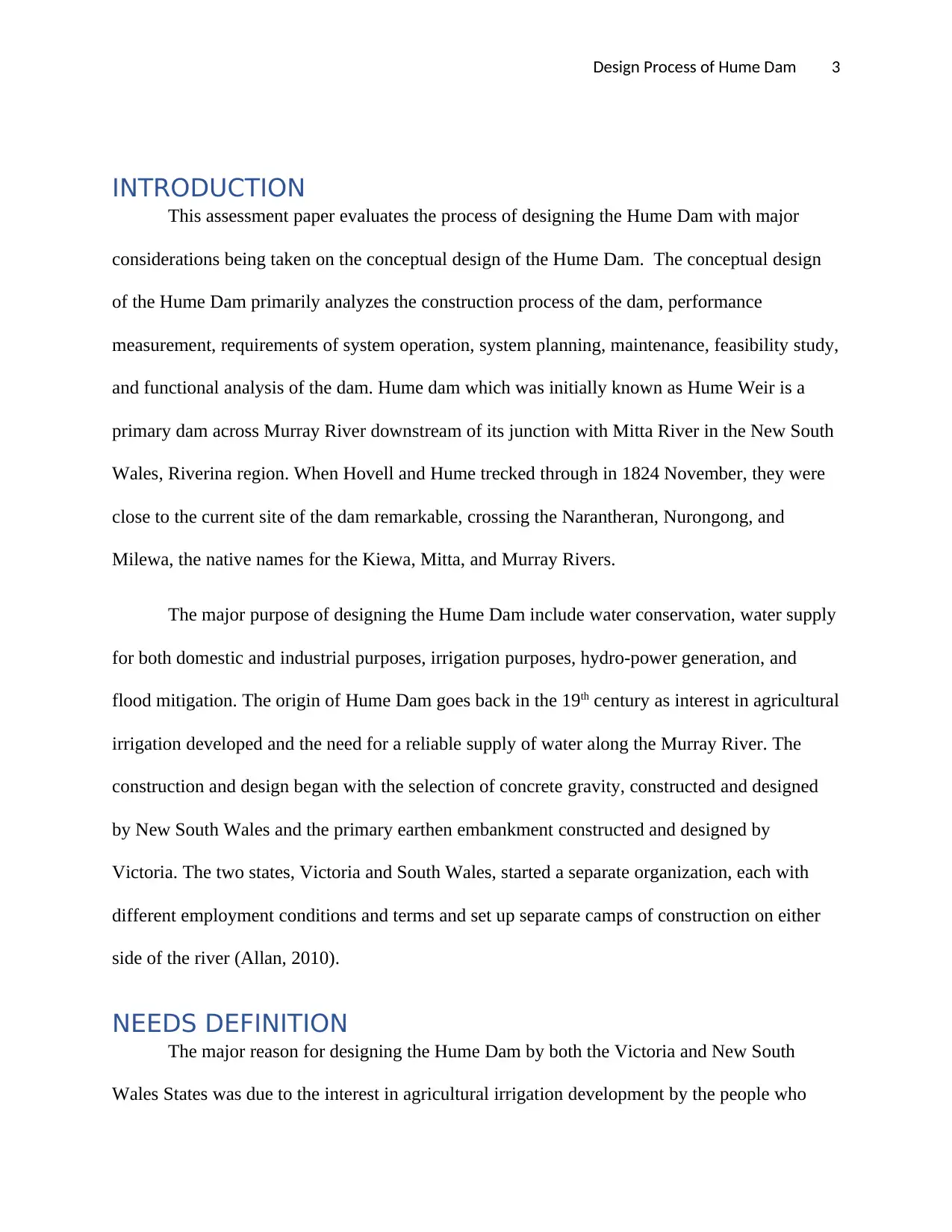
Design Process of Hume Dam 3
INTRODUCTION
This assessment paper evaluates the process of designing the Hume Dam with major
considerations being taken on the conceptual design of the Hume Dam. The conceptual design
of the Hume Dam primarily analyzes the construction process of the dam, performance
measurement, requirements of system operation, system planning, maintenance, feasibility study,
and functional analysis of the dam. Hume dam which was initially known as Hume Weir is a
primary dam across Murray River downstream of its junction with Mitta River in the New South
Wales, Riverina region. When Hovell and Hume trecked through in 1824 November, they were
close to the current site of the dam remarkable, crossing the Narantheran, Nurongong, and
Milewa, the native names for the Kiewa, Mitta, and Murray Rivers.
The major purpose of designing the Hume Dam include water conservation, water supply
for both domestic and industrial purposes, irrigation purposes, hydro-power generation, and
flood mitigation. The origin of Hume Dam goes back in the 19th century as interest in agricultural
irrigation developed and the need for a reliable supply of water along the Murray River. The
construction and design began with the selection of concrete gravity, constructed and designed
by New South Wales and the primary earthen embankment constructed and designed by
Victoria. The two states, Victoria and South Wales, started a separate organization, each with
different employment conditions and terms and set up separate camps of construction on either
side of the river (Allan, 2010).
NEEDS DEFINITION
The major reason for designing the Hume Dam by both the Victoria and New South
Wales States was due to the interest in agricultural irrigation development by the people who
INTRODUCTION
This assessment paper evaluates the process of designing the Hume Dam with major
considerations being taken on the conceptual design of the Hume Dam. The conceptual design
of the Hume Dam primarily analyzes the construction process of the dam, performance
measurement, requirements of system operation, system planning, maintenance, feasibility study,
and functional analysis of the dam. Hume dam which was initially known as Hume Weir is a
primary dam across Murray River downstream of its junction with Mitta River in the New South
Wales, Riverina region. When Hovell and Hume trecked through in 1824 November, they were
close to the current site of the dam remarkable, crossing the Narantheran, Nurongong, and
Milewa, the native names for the Kiewa, Mitta, and Murray Rivers.
The major purpose of designing the Hume Dam include water conservation, water supply
for both domestic and industrial purposes, irrigation purposes, hydro-power generation, and
flood mitigation. The origin of Hume Dam goes back in the 19th century as interest in agricultural
irrigation developed and the need for a reliable supply of water along the Murray River. The
construction and design began with the selection of concrete gravity, constructed and designed
by New South Wales and the primary earthen embankment constructed and designed by
Victoria. The two states, Victoria and South Wales, started a separate organization, each with
different employment conditions and terms and set up separate camps of construction on either
side of the river (Allan, 2010).
NEEDS DEFINITION
The major reason for designing the Hume Dam by both the Victoria and New South
Wales States was due to the interest in agricultural irrigation development by the people who
⊘ This is a preview!⊘
Do you want full access?
Subscribe today to unlock all pages.

Trusted by 1+ million students worldwide
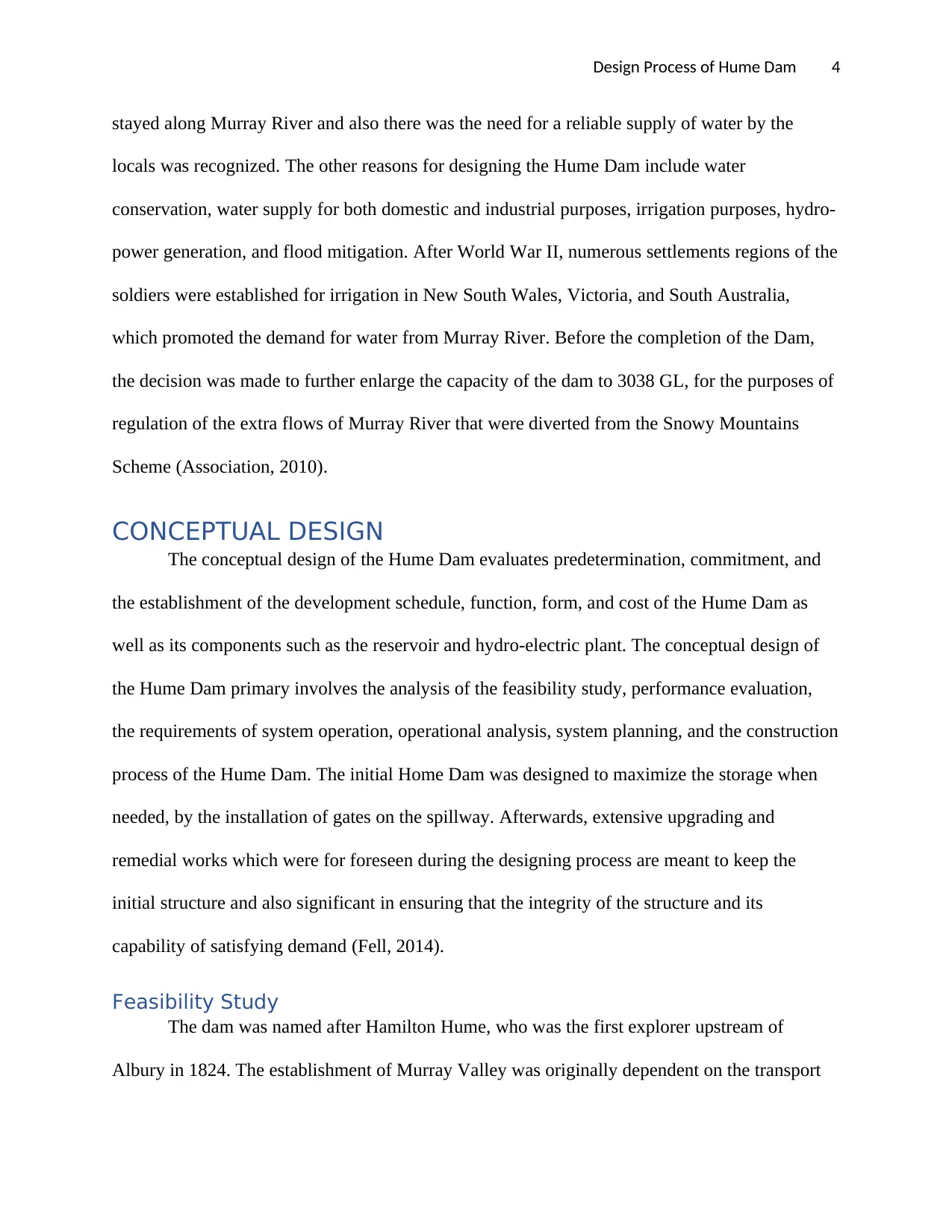
Design Process of Hume Dam 4
stayed along Murray River and also there was the need for a reliable supply of water by the
locals was recognized. The other reasons for designing the Hume Dam include water
conservation, water supply for both domestic and industrial purposes, irrigation purposes, hydro-
power generation, and flood mitigation. After World War II, numerous settlements regions of the
soldiers were established for irrigation in New South Wales, Victoria, and South Australia,
which promoted the demand for water from Murray River. Before the completion of the Dam,
the decision was made to further enlarge the capacity of the dam to 3038 GL, for the purposes of
regulation of the extra flows of Murray River that were diverted from the Snowy Mountains
Scheme (Association, 2010).
CONCEPTUAL DESIGN
The conceptual design of the Hume Dam evaluates predetermination, commitment, and
the establishment of the development schedule, function, form, and cost of the Hume Dam as
well as its components such as the reservoir and hydro-electric plant. The conceptual design of
the Hume Dam primary involves the analysis of the feasibility study, performance evaluation,
the requirements of system operation, operational analysis, system planning, and the construction
process of the Hume Dam. The initial Home Dam was designed to maximize the storage when
needed, by the installation of gates on the spillway. Afterwards, extensive upgrading and
remedial works which were for foreseen during the designing process are meant to keep the
initial structure and also significant in ensuring that the integrity of the structure and its
capability of satisfying demand (Fell, 2014).
Feasibility Study
The dam was named after Hamilton Hume, who was the first explorer upstream of
Albury in 1824. The establishment of Murray Valley was originally dependent on the transport
stayed along Murray River and also there was the need for a reliable supply of water by the
locals was recognized. The other reasons for designing the Hume Dam include water
conservation, water supply for both domestic and industrial purposes, irrigation purposes, hydro-
power generation, and flood mitigation. After World War II, numerous settlements regions of the
soldiers were established for irrigation in New South Wales, Victoria, and South Australia,
which promoted the demand for water from Murray River. Before the completion of the Dam,
the decision was made to further enlarge the capacity of the dam to 3038 GL, for the purposes of
regulation of the extra flows of Murray River that were diverted from the Snowy Mountains
Scheme (Association, 2010).
CONCEPTUAL DESIGN
The conceptual design of the Hume Dam evaluates predetermination, commitment, and
the establishment of the development schedule, function, form, and cost of the Hume Dam as
well as its components such as the reservoir and hydro-electric plant. The conceptual design of
the Hume Dam primary involves the analysis of the feasibility study, performance evaluation,
the requirements of system operation, operational analysis, system planning, and the construction
process of the Hume Dam. The initial Home Dam was designed to maximize the storage when
needed, by the installation of gates on the spillway. Afterwards, extensive upgrading and
remedial works which were for foreseen during the designing process are meant to keep the
initial structure and also significant in ensuring that the integrity of the structure and its
capability of satisfying demand (Fell, 2014).
Feasibility Study
The dam was named after Hamilton Hume, who was the first explorer upstream of
Albury in 1824. The establishment of Murray Valley was originally dependent on the transport
Paraphrase This Document
Need a fresh take? Get an instant paraphrase of this document with our AI Paraphraser
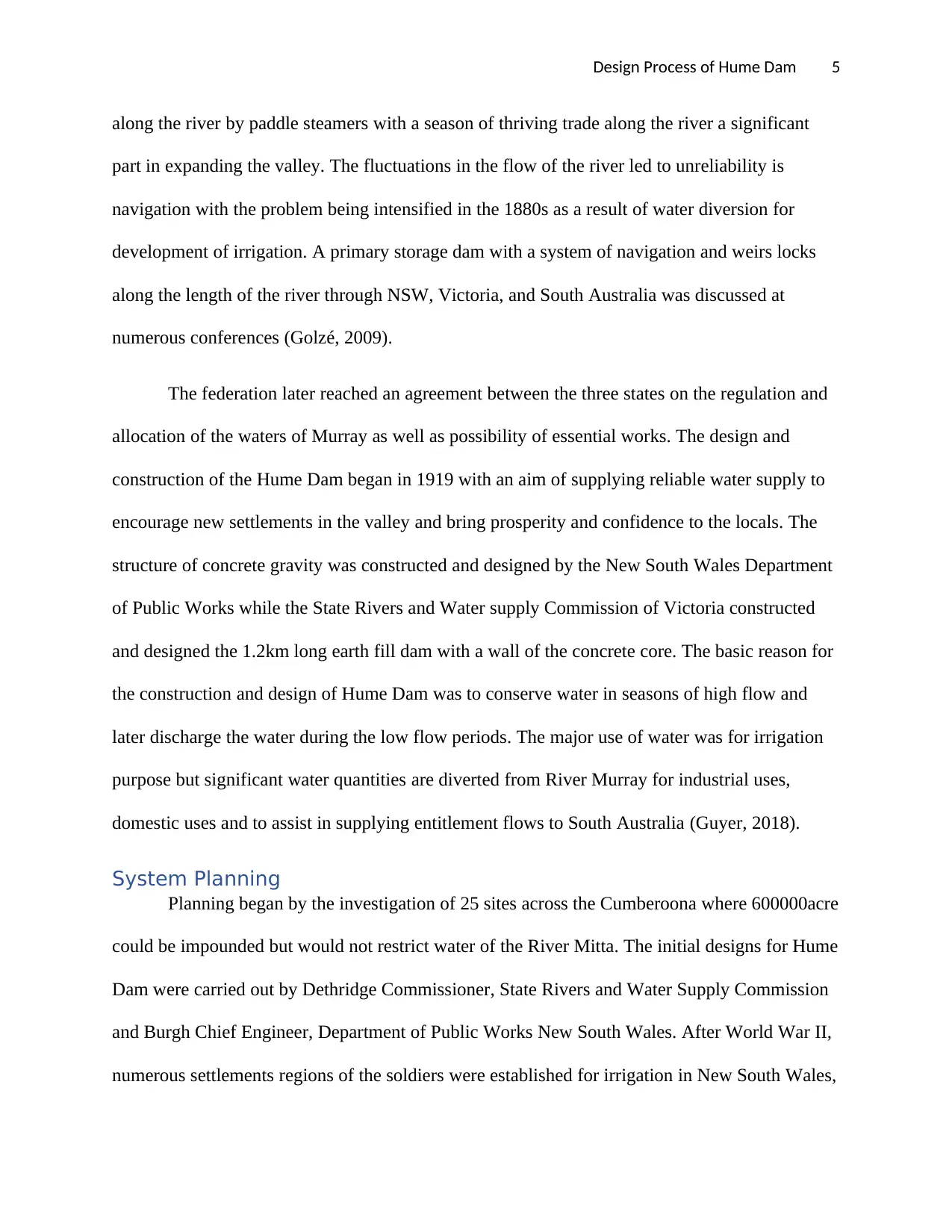
Design Process of Hume Dam 5
along the river by paddle steamers with a season of thriving trade along the river a significant
part in expanding the valley. The fluctuations in the flow of the river led to unreliability is
navigation with the problem being intensified in the 1880s as a result of water diversion for
development of irrigation. A primary storage dam with a system of navigation and weirs locks
along the length of the river through NSW, Victoria, and South Australia was discussed at
numerous conferences (Golzé, 2009).
The federation later reached an agreement between the three states on the regulation and
allocation of the waters of Murray as well as possibility of essential works. The design and
construction of the Hume Dam began in 1919 with an aim of supplying reliable water supply to
encourage new settlements in the valley and bring prosperity and confidence to the locals. The
structure of concrete gravity was constructed and designed by the New South Wales Department
of Public Works while the State Rivers and Water supply Commission of Victoria constructed
and designed the 1.2km long earth fill dam with a wall of the concrete core. The basic reason for
the construction and design of Hume Dam was to conserve water in seasons of high flow and
later discharge the water during the low flow periods. The major use of water was for irrigation
purpose but significant water quantities are diverted from River Murray for industrial uses,
domestic uses and to assist in supplying entitlement flows to South Australia (Guyer, 2018).
System Planning
Planning began by the investigation of 25 sites across the Cumberoona where 600000acre
could be impounded but would not restrict water of the River Mitta. The initial designs for Hume
Dam were carried out by Dethridge Commissioner, State Rivers and Water Supply Commission
and Burgh Chief Engineer, Department of Public Works New South Wales. After World War II,
numerous settlements regions of the soldiers were established for irrigation in New South Wales,
along the river by paddle steamers with a season of thriving trade along the river a significant
part in expanding the valley. The fluctuations in the flow of the river led to unreliability is
navigation with the problem being intensified in the 1880s as a result of water diversion for
development of irrigation. A primary storage dam with a system of navigation and weirs locks
along the length of the river through NSW, Victoria, and South Australia was discussed at
numerous conferences (Golzé, 2009).
The federation later reached an agreement between the three states on the regulation and
allocation of the waters of Murray as well as possibility of essential works. The design and
construction of the Hume Dam began in 1919 with an aim of supplying reliable water supply to
encourage new settlements in the valley and bring prosperity and confidence to the locals. The
structure of concrete gravity was constructed and designed by the New South Wales Department
of Public Works while the State Rivers and Water supply Commission of Victoria constructed
and designed the 1.2km long earth fill dam with a wall of the concrete core. The basic reason for
the construction and design of Hume Dam was to conserve water in seasons of high flow and
later discharge the water during the low flow periods. The major use of water was for irrigation
purpose but significant water quantities are diverted from River Murray for industrial uses,
domestic uses and to assist in supplying entitlement flows to South Australia (Guyer, 2018).
System Planning
Planning began by the investigation of 25 sites across the Cumberoona where 600000acre
could be impounded but would not restrict water of the River Mitta. The initial designs for Hume
Dam were carried out by Dethridge Commissioner, State Rivers and Water Supply Commission
and Burgh Chief Engineer, Department of Public Works New South Wales. After World War II,
numerous settlements regions of the soldiers were established for irrigation in New South Wales,
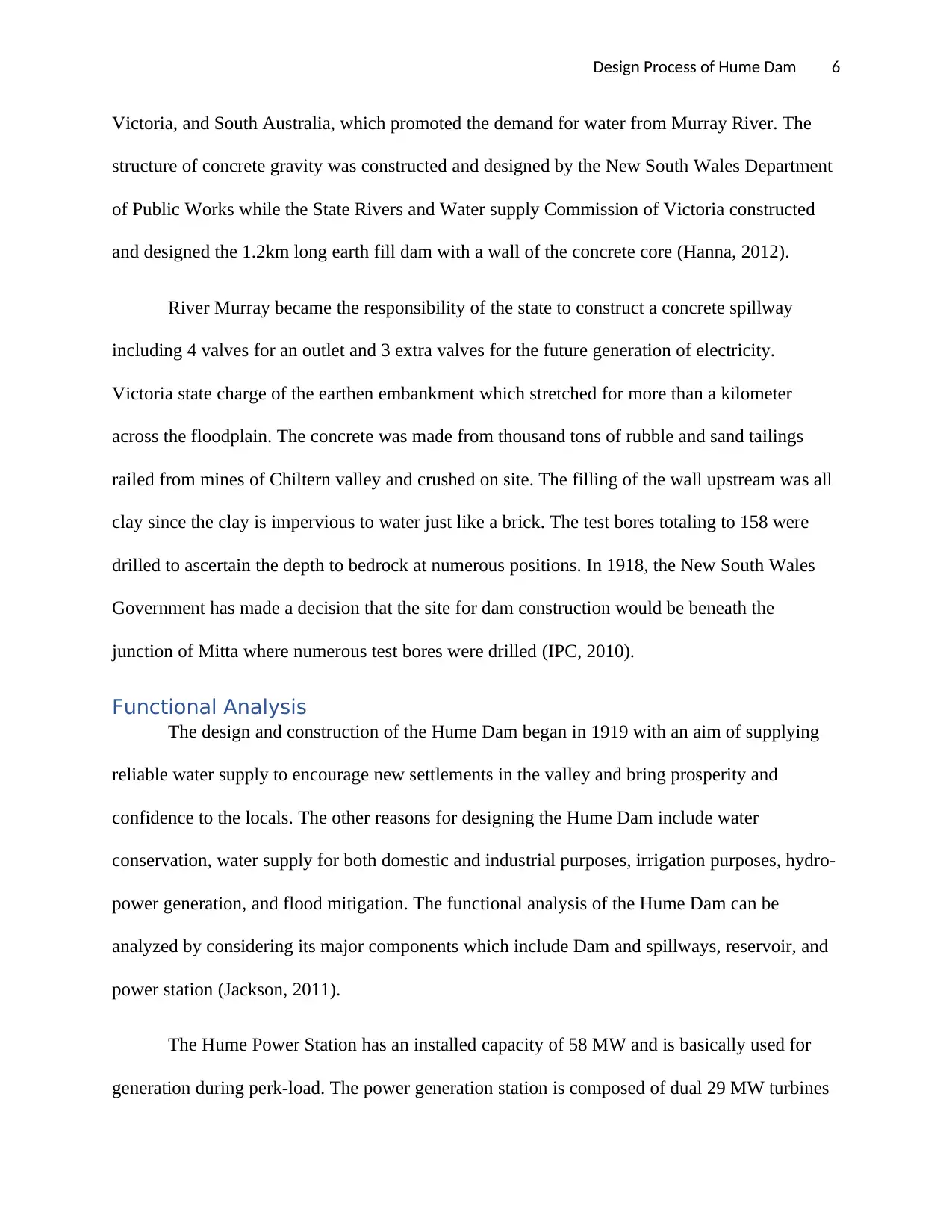
Design Process of Hume Dam 6
Victoria, and South Australia, which promoted the demand for water from Murray River. The
structure of concrete gravity was constructed and designed by the New South Wales Department
of Public Works while the State Rivers and Water supply Commission of Victoria constructed
and designed the 1.2km long earth fill dam with a wall of the concrete core (Hanna, 2012).
River Murray became the responsibility of the state to construct a concrete spillway
including 4 valves for an outlet and 3 extra valves for the future generation of electricity.
Victoria state charge of the earthen embankment which stretched for more than a kilometer
across the floodplain. The concrete was made from thousand tons of rubble and sand tailings
railed from mines of Chiltern valley and crushed on site. The filling of the wall upstream was all
clay since the clay is impervious to water just like a brick. The test bores totaling to 158 were
drilled to ascertain the depth to bedrock at numerous positions. In 1918, the New South Wales
Government has made a decision that the site for dam construction would be beneath the
junction of Mitta where numerous test bores were drilled (IPC, 2010).
Functional Analysis
The design and construction of the Hume Dam began in 1919 with an aim of supplying
reliable water supply to encourage new settlements in the valley and bring prosperity and
confidence to the locals. The other reasons for designing the Hume Dam include water
conservation, water supply for both domestic and industrial purposes, irrigation purposes, hydro-
power generation, and flood mitigation. The functional analysis of the Hume Dam can be
analyzed by considering its major components which include Dam and spillways, reservoir, and
power station (Jackson, 2011).
The Hume Power Station has an installed capacity of 58 MW and is basically used for
generation during perk-load. The power generation station is composed of dual 29 MW turbines
Victoria, and South Australia, which promoted the demand for water from Murray River. The
structure of concrete gravity was constructed and designed by the New South Wales Department
of Public Works while the State Rivers and Water supply Commission of Victoria constructed
and designed the 1.2km long earth fill dam with a wall of the concrete core (Hanna, 2012).
River Murray became the responsibility of the state to construct a concrete spillway
including 4 valves for an outlet and 3 extra valves for the future generation of electricity.
Victoria state charge of the earthen embankment which stretched for more than a kilometer
across the floodplain. The concrete was made from thousand tons of rubble and sand tailings
railed from mines of Chiltern valley and crushed on site. The filling of the wall upstream was all
clay since the clay is impervious to water just like a brick. The test bores totaling to 158 were
drilled to ascertain the depth to bedrock at numerous positions. In 1918, the New South Wales
Government has made a decision that the site for dam construction would be beneath the
junction of Mitta where numerous test bores were drilled (IPC, 2010).
Functional Analysis
The design and construction of the Hume Dam began in 1919 with an aim of supplying
reliable water supply to encourage new settlements in the valley and bring prosperity and
confidence to the locals. The other reasons for designing the Hume Dam include water
conservation, water supply for both domestic and industrial purposes, irrigation purposes, hydro-
power generation, and flood mitigation. The functional analysis of the Hume Dam can be
analyzed by considering its major components which include Dam and spillways, reservoir, and
power station (Jackson, 2011).
The Hume Power Station has an installed capacity of 58 MW and is basically used for
generation during perk-load. The power generation station is composed of dual 29 MW turbines
⊘ This is a preview!⊘
Do you want full access?
Subscribe today to unlock all pages.

Trusted by 1+ million students worldwide
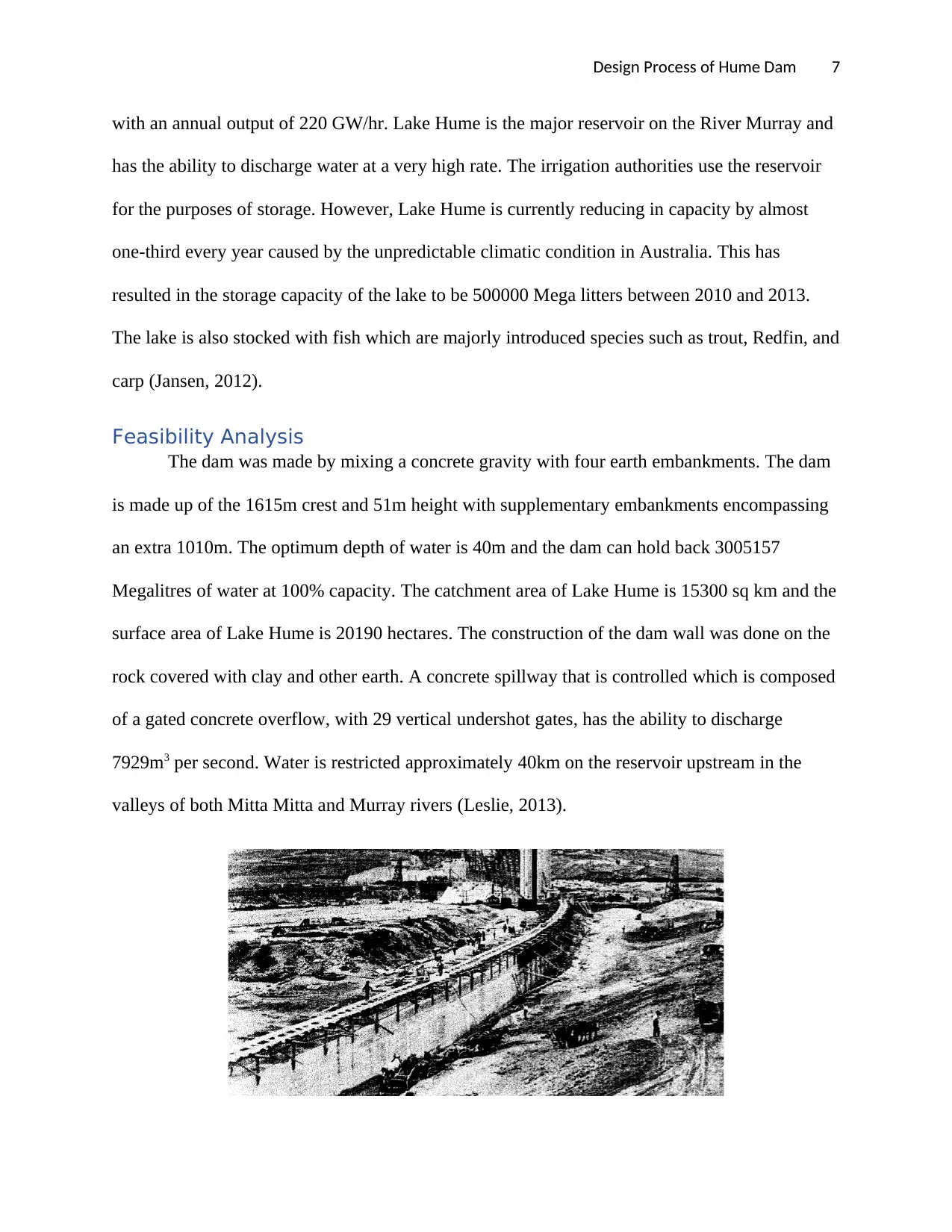
Design Process of Hume Dam 7
with an annual output of 220 GW/hr. Lake Hume is the major reservoir on the River Murray and
has the ability to discharge water at a very high rate. The irrigation authorities use the reservoir
for the purposes of storage. However, Lake Hume is currently reducing in capacity by almost
one-third every year caused by the unpredictable climatic condition in Australia. This has
resulted in the storage capacity of the lake to be 500000 Mega litters between 2010 and 2013.
The lake is also stocked with fish which are majorly introduced species such as trout, Redfin, and
carp (Jansen, 2012).
Feasibility Analysis
The dam was made by mixing a concrete gravity with four earth embankments. The dam
is made up of the 1615m crest and 51m height with supplementary embankments encompassing
an extra 1010m. The optimum depth of water is 40m and the dam can hold back 3005157
Megalitres of water at 100% capacity. The catchment area of Lake Hume is 15300 sq km and the
surface area of Lake Hume is 20190 hectares. The construction of the dam wall was done on the
rock covered with clay and other earth. A concrete spillway that is controlled which is composed
of a gated concrete overflow, with 29 vertical undershot gates, has the ability to discharge
7929m3 per second. Water is restricted approximately 40km on the reservoir upstream in the
valleys of both Mitta Mitta and Murray rivers (Leslie, 2013).
with an annual output of 220 GW/hr. Lake Hume is the major reservoir on the River Murray and
has the ability to discharge water at a very high rate. The irrigation authorities use the reservoir
for the purposes of storage. However, Lake Hume is currently reducing in capacity by almost
one-third every year caused by the unpredictable climatic condition in Australia. This has
resulted in the storage capacity of the lake to be 500000 Mega litters between 2010 and 2013.
The lake is also stocked with fish which are majorly introduced species such as trout, Redfin, and
carp (Jansen, 2012).
Feasibility Analysis
The dam was made by mixing a concrete gravity with four earth embankments. The dam
is made up of the 1615m crest and 51m height with supplementary embankments encompassing
an extra 1010m. The optimum depth of water is 40m and the dam can hold back 3005157
Megalitres of water at 100% capacity. The catchment area of Lake Hume is 15300 sq km and the
surface area of Lake Hume is 20190 hectares. The construction of the dam wall was done on the
rock covered with clay and other earth. A concrete spillway that is controlled which is composed
of a gated concrete overflow, with 29 vertical undershot gates, has the ability to discharge
7929m3 per second. Water is restricted approximately 40km on the reservoir upstream in the
valleys of both Mitta Mitta and Murray rivers (Leslie, 2013).
Paraphrase This Document
Need a fresh take? Get an instant paraphrase of this document with our AI Paraphraser
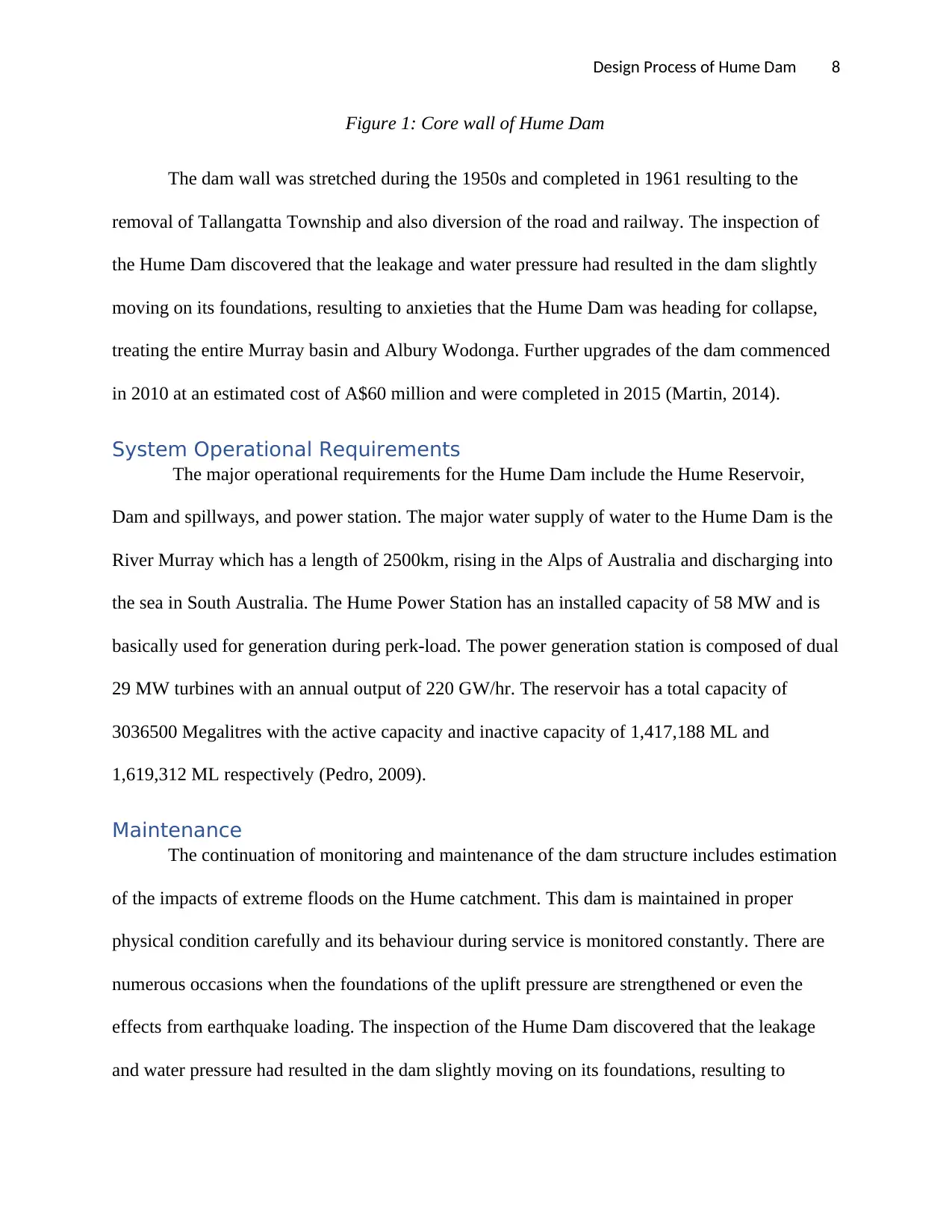
Design Process of Hume Dam 8
Figure 1: Core wall of Hume Dam
The dam wall was stretched during the 1950s and completed in 1961 resulting to the
removal of Tallangatta Township and also diversion of the road and railway. The inspection of
the Hume Dam discovered that the leakage and water pressure had resulted in the dam slightly
moving on its foundations, resulting to anxieties that the Hume Dam was heading for collapse,
treating the entire Murray basin and Albury Wodonga. Further upgrades of the dam commenced
in 2010 at an estimated cost of A$60 million and were completed in 2015 (Martin, 2014).
System Operational Requirements
The major operational requirements for the Hume Dam include the Hume Reservoir,
Dam and spillways, and power station. The major water supply of water to the Hume Dam is the
River Murray which has a length of 2500km, rising in the Alps of Australia and discharging into
the sea in South Australia. The Hume Power Station has an installed capacity of 58 MW and is
basically used for generation during perk-load. The power generation station is composed of dual
29 MW turbines with an annual output of 220 GW/hr. The reservoir has a total capacity of
3036500 Megalitres with the active capacity and inactive capacity of 1,417,188 ML and
1,619,312 ML respectively (Pedro, 2009).
Maintenance
The continuation of monitoring and maintenance of the dam structure includes estimation
of the impacts of extreme floods on the Hume catchment. This dam is maintained in proper
physical condition carefully and its behaviour during service is monitored constantly. There are
numerous occasions when the foundations of the uplift pressure are strengthened or even the
effects from earthquake loading. The inspection of the Hume Dam discovered that the leakage
and water pressure had resulted in the dam slightly moving on its foundations, resulting to
Figure 1: Core wall of Hume Dam
The dam wall was stretched during the 1950s and completed in 1961 resulting to the
removal of Tallangatta Township and also diversion of the road and railway. The inspection of
the Hume Dam discovered that the leakage and water pressure had resulted in the dam slightly
moving on its foundations, resulting to anxieties that the Hume Dam was heading for collapse,
treating the entire Murray basin and Albury Wodonga. Further upgrades of the dam commenced
in 2010 at an estimated cost of A$60 million and were completed in 2015 (Martin, 2014).
System Operational Requirements
The major operational requirements for the Hume Dam include the Hume Reservoir,
Dam and spillways, and power station. The major water supply of water to the Hume Dam is the
River Murray which has a length of 2500km, rising in the Alps of Australia and discharging into
the sea in South Australia. The Hume Power Station has an installed capacity of 58 MW and is
basically used for generation during perk-load. The power generation station is composed of dual
29 MW turbines with an annual output of 220 GW/hr. The reservoir has a total capacity of
3036500 Megalitres with the active capacity and inactive capacity of 1,417,188 ML and
1,619,312 ML respectively (Pedro, 2009).
Maintenance
The continuation of monitoring and maintenance of the dam structure includes estimation
of the impacts of extreme floods on the Hume catchment. This dam is maintained in proper
physical condition carefully and its behaviour during service is monitored constantly. There are
numerous occasions when the foundations of the uplift pressure are strengthened or even the
effects from earthquake loading. The inspection of the Hume Dam discovered that the leakage
and water pressure had resulted in the dam slightly moving on its foundations, resulting to
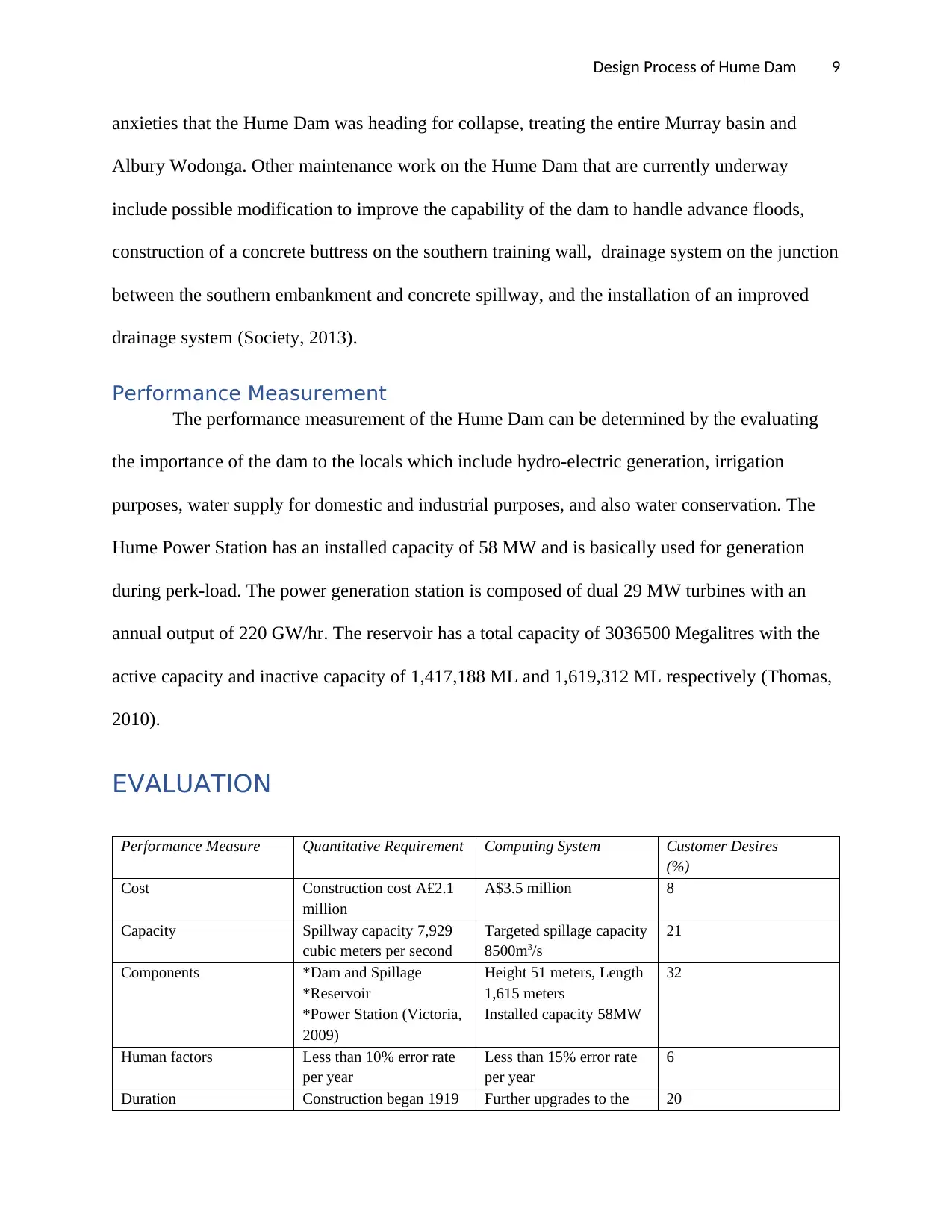
Design Process of Hume Dam 9
anxieties that the Hume Dam was heading for collapse, treating the entire Murray basin and
Albury Wodonga. Other maintenance work on the Hume Dam that are currently underway
include possible modification to improve the capability of the dam to handle advance floods,
construction of a concrete buttress on the southern training wall, drainage system on the junction
between the southern embankment and concrete spillway, and the installation of an improved
drainage system (Society, 2013).
Performance Measurement
The performance measurement of the Hume Dam can be determined by the evaluating
the importance of the dam to the locals which include hydro-electric generation, irrigation
purposes, water supply for domestic and industrial purposes, and also water conservation. The
Hume Power Station has an installed capacity of 58 MW and is basically used for generation
during perk-load. The power generation station is composed of dual 29 MW turbines with an
annual output of 220 GW/hr. The reservoir has a total capacity of 3036500 Megalitres with the
active capacity and inactive capacity of 1,417,188 ML and 1,619,312 ML respectively (Thomas,
2010).
EVALUATION
Performance Measure Quantitative Requirement Computing System Customer Desires
(%)
Cost Construction cost A£2.1
million
A$3.5 million 8
Capacity Spillway capacity 7,929
cubic meters per second
Targeted spillage capacity
8500m3/s
21
Components *Dam and Spillage
*Reservoir
*Power Station (Victoria,
2009)
Height 51 meters, Length
1,615 meters
Installed capacity 58MW
32
Human factors Less than 10% error rate
per year
Less than 15% error rate
per year
6
Duration Construction began 1919 Further upgrades to the 20
anxieties that the Hume Dam was heading for collapse, treating the entire Murray basin and
Albury Wodonga. Other maintenance work on the Hume Dam that are currently underway
include possible modification to improve the capability of the dam to handle advance floods,
construction of a concrete buttress on the southern training wall, drainage system on the junction
between the southern embankment and concrete spillway, and the installation of an improved
drainage system (Society, 2013).
Performance Measurement
The performance measurement of the Hume Dam can be determined by the evaluating
the importance of the dam to the locals which include hydro-electric generation, irrigation
purposes, water supply for domestic and industrial purposes, and also water conservation. The
Hume Power Station has an installed capacity of 58 MW and is basically used for generation
during perk-load. The power generation station is composed of dual 29 MW turbines with an
annual output of 220 GW/hr. The reservoir has a total capacity of 3036500 Megalitres with the
active capacity and inactive capacity of 1,417,188 ML and 1,619,312 ML respectively (Thomas,
2010).
EVALUATION
Performance Measure Quantitative Requirement Computing System Customer Desires
(%)
Cost Construction cost A£2.1
million
A$3.5 million 8
Capacity Spillway capacity 7,929
cubic meters per second
Targeted spillage capacity
8500m3/s
21
Components *Dam and Spillage
*Reservoir
*Power Station (Victoria,
2009)
Height 51 meters, Length
1,615 meters
Installed capacity 58MW
32
Human factors Less than 10% error rate
per year
Less than 15% error rate
per year
6
Duration Construction began 1919 Further upgrades to the 20
⊘ This is a preview!⊘
Do you want full access?
Subscribe today to unlock all pages.

Trusted by 1+ million students worldwide
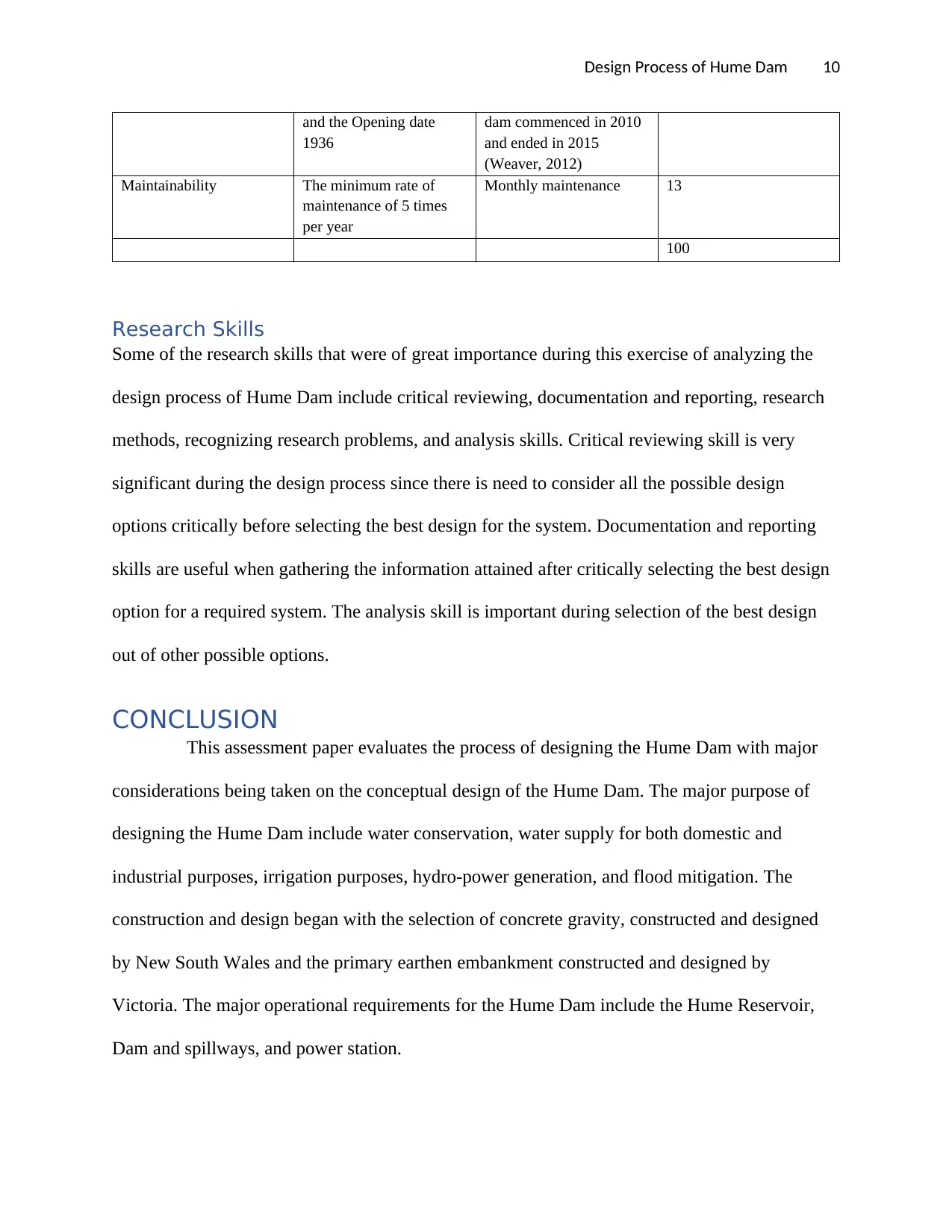
Design Process of Hume Dam 10
and the Opening date
1936
dam commenced in 2010
and ended in 2015
(Weaver, 2012)
Maintainability The minimum rate of
maintenance of 5 times
per year
Monthly maintenance 13
100
Research Skills
Some of the research skills that were of great importance during this exercise of analyzing the
design process of Hume Dam include critical reviewing, documentation and reporting, research
methods, recognizing research problems, and analysis skills. Critical reviewing skill is very
significant during the design process since there is need to consider all the possible design
options critically before selecting the best design for the system. Documentation and reporting
skills are useful when gathering the information attained after critically selecting the best design
option for a required system. The analysis skill is important during selection of the best design
out of other possible options.
CONCLUSION
This assessment paper evaluates the process of designing the Hume Dam with major
considerations being taken on the conceptual design of the Hume Dam. The major purpose of
designing the Hume Dam include water conservation, water supply for both domestic and
industrial purposes, irrigation purposes, hydro-power generation, and flood mitigation. The
construction and design began with the selection of concrete gravity, constructed and designed
by New South Wales and the primary earthen embankment constructed and designed by
Victoria. The major operational requirements for the Hume Dam include the Hume Reservoir,
Dam and spillways, and power station.
and the Opening date
1936
dam commenced in 2010
and ended in 2015
(Weaver, 2012)
Maintainability The minimum rate of
maintenance of 5 times
per year
Monthly maintenance 13
100
Research Skills
Some of the research skills that were of great importance during this exercise of analyzing the
design process of Hume Dam include critical reviewing, documentation and reporting, research
methods, recognizing research problems, and analysis skills. Critical reviewing skill is very
significant during the design process since there is need to consider all the possible design
options critically before selecting the best design for the system. Documentation and reporting
skills are useful when gathering the information attained after critically selecting the best design
option for a required system. The analysis skill is important during selection of the best design
out of other possible options.
CONCLUSION
This assessment paper evaluates the process of designing the Hume Dam with major
considerations being taken on the conceptual design of the Hume Dam. The major purpose of
designing the Hume Dam include water conservation, water supply for both domestic and
industrial purposes, irrigation purposes, hydro-power generation, and flood mitigation. The
construction and design began with the selection of concrete gravity, constructed and designed
by New South Wales and the primary earthen embankment constructed and designed by
Victoria. The major operational requirements for the Hume Dam include the Hume Reservoir,
Dam and spillways, and power station.
Paraphrase This Document
Need a fresh take? Get an instant paraphrase of this document with our AI Paraphraser
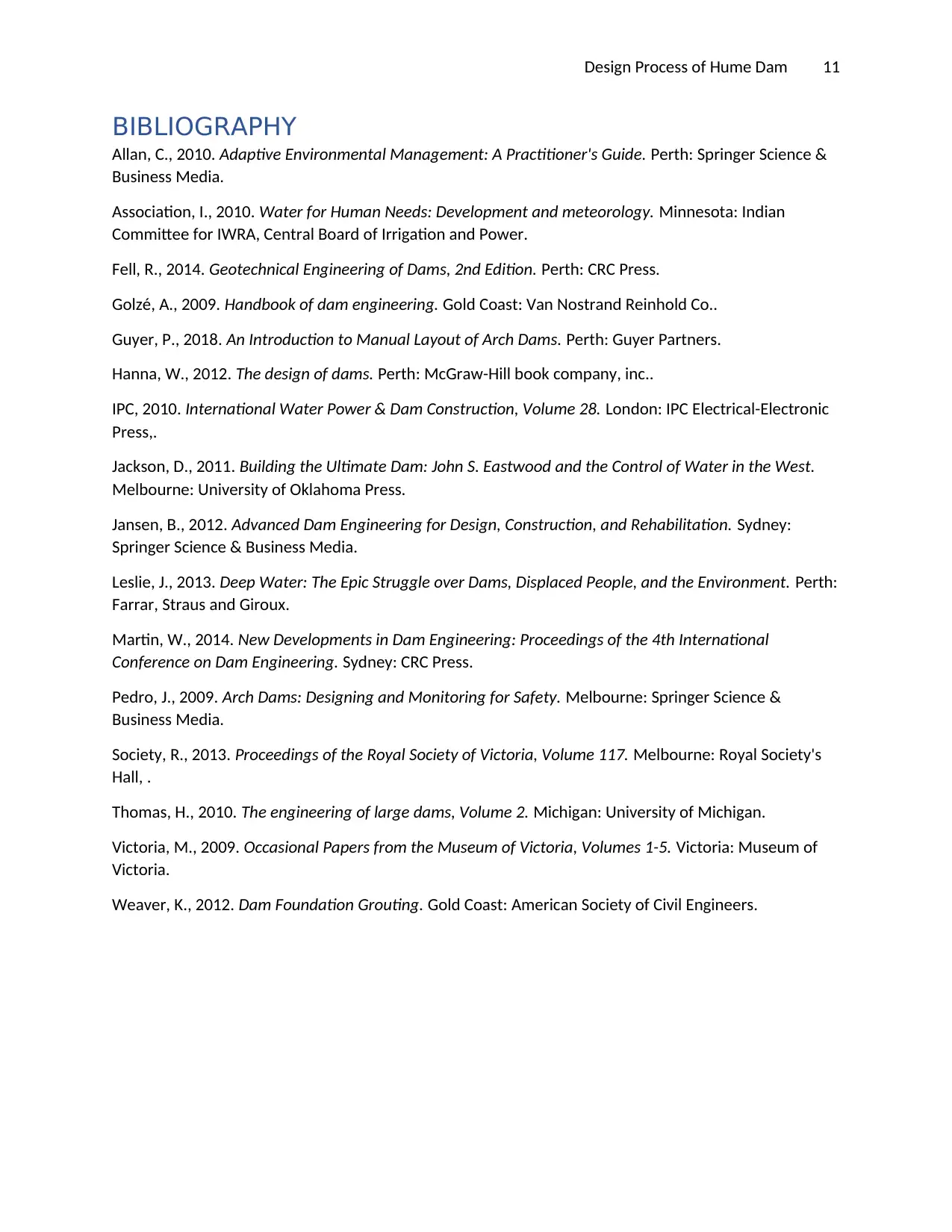
Design Process of Hume Dam 11
BIBLIOGRAPHY
Allan, C., 2010. Adaptive Environmental Management: A Practitioner's Guide. Perth: Springer Science &
Business Media.
Association, I., 2010. Water for Human Needs: Development and meteorology. Minnesota: Indian
Committee for IWRA, Central Board of Irrigation and Power.
Fell, R., 2014. Geotechnical Engineering of Dams, 2nd Edition. Perth: CRC Press.
Golzé, A., 2009. Handbook of dam engineering. Gold Coast: Van Nostrand Reinhold Co..
Guyer, P., 2018. An Introduction to Manual Layout of Arch Dams. Perth: Guyer Partners.
Hanna, W., 2012. The design of dams. Perth: McGraw-Hill book company, inc..
IPC, 2010. International Water Power & Dam Construction, Volume 28. London: IPC Electrical-Electronic
Press,.
Jackson, D., 2011. Building the Ultimate Dam: John S. Eastwood and the Control of Water in the West.
Melbourne: University of Oklahoma Press.
Jansen, B., 2012. Advanced Dam Engineering for Design, Construction, and Rehabilitation. Sydney:
Springer Science & Business Media.
Leslie, J., 2013. Deep Water: The Epic Struggle over Dams, Displaced People, and the Environment. Perth:
Farrar, Straus and Giroux.
Martin, W., 2014. New Developments in Dam Engineering: Proceedings of the 4th International
Conference on Dam Engineering. Sydney: CRC Press.
Pedro, J., 2009. Arch Dams: Designing and Monitoring for Safety. Melbourne: Springer Science &
Business Media.
Society, R., 2013. Proceedings of the Royal Society of Victoria, Volume 117. Melbourne: Royal Society's
Hall, .
Thomas, H., 2010. The engineering of large dams, Volume 2. Michigan: University of Michigan.
Victoria, M., 2009. Occasional Papers from the Museum of Victoria, Volumes 1-5. Victoria: Museum of
Victoria.
Weaver, K., 2012. Dam Foundation Grouting. Gold Coast: American Society of Civil Engineers.
BIBLIOGRAPHY
Allan, C., 2010. Adaptive Environmental Management: A Practitioner's Guide. Perth: Springer Science &
Business Media.
Association, I., 2010. Water for Human Needs: Development and meteorology. Minnesota: Indian
Committee for IWRA, Central Board of Irrigation and Power.
Fell, R., 2014. Geotechnical Engineering of Dams, 2nd Edition. Perth: CRC Press.
Golzé, A., 2009. Handbook of dam engineering. Gold Coast: Van Nostrand Reinhold Co..
Guyer, P., 2018. An Introduction to Manual Layout of Arch Dams. Perth: Guyer Partners.
Hanna, W., 2012. The design of dams. Perth: McGraw-Hill book company, inc..
IPC, 2010. International Water Power & Dam Construction, Volume 28. London: IPC Electrical-Electronic
Press,.
Jackson, D., 2011. Building the Ultimate Dam: John S. Eastwood and the Control of Water in the West.
Melbourne: University of Oklahoma Press.
Jansen, B., 2012. Advanced Dam Engineering for Design, Construction, and Rehabilitation. Sydney:
Springer Science & Business Media.
Leslie, J., 2013. Deep Water: The Epic Struggle over Dams, Displaced People, and the Environment. Perth:
Farrar, Straus and Giroux.
Martin, W., 2014. New Developments in Dam Engineering: Proceedings of the 4th International
Conference on Dam Engineering. Sydney: CRC Press.
Pedro, J., 2009. Arch Dams: Designing and Monitoring for Safety. Melbourne: Springer Science &
Business Media.
Society, R., 2013. Proceedings of the Royal Society of Victoria, Volume 117. Melbourne: Royal Society's
Hall, .
Thomas, H., 2010. The engineering of large dams, Volume 2. Michigan: University of Michigan.
Victoria, M., 2009. Occasional Papers from the Museum of Victoria, Volumes 1-5. Victoria: Museum of
Victoria.
Weaver, K., 2012. Dam Foundation Grouting. Gold Coast: American Society of Civil Engineers.
1 out of 11
Related Documents
Your All-in-One AI-Powered Toolkit for Academic Success.
+13062052269
info@desklib.com
Available 24*7 on WhatsApp / Email
![[object Object]](/_next/static/media/star-bottom.7253800d.svg)
Unlock your academic potential
Copyright © 2020–2025 A2Z Services. All Rights Reserved. Developed and managed by ZUCOL.




